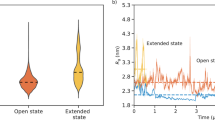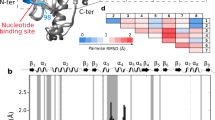Abstract
Genetics experiments have identified six mutations located in the subdomain IA (A17V, R23H, G32D, G32S, R34K, V372I) of Ssa1 that influence propagation of the yeast [PSI+] prion. However, the underlining molecular mechanisms of these mutations are still unclear. The six mutation sites are present in the IA subdomain of the nucleotide-binding domain (NBD). The ATPase subdomain IA is a critical mediator of inter-domain allostery in Hsp70 molecular chaperones, so the mutation and changes in this subdomain may influence the function of the substrate-binding domain. In addition, ADP release is a rate-limiting step of the ATPase cycle and dysregulation of the ATPase cycle influences the propagation of the yeast [PSI+] prion. In this work, steered molecular dynamics (SMD) simulations were performed to explore the interaction between ADP and NBD. Results suggest that during the SMD simulations, hydrophobic interactions are predominant and variations in the binding state of ADP within the mutants is a potential reason for in vivo effects on yeast [PSI+] prion propagation. Additionally, we identify the primary residues in the ATPase domain that directly constitute the main hydrophobic interaction network and directly influence the ADP interaction state with the NBD of Ssa1. Furthermore, this in silico analysis reaffirms the importance of previously experimentally-determined residues in the Hsp70 ATPase domain involved in ADP binding and also identifies new residues potentially involved in this process.







Similar content being viewed by others
References
Hartl FU, Hayer-Hartl M (2002) Molecular chaperones in the cytosol: from nascent chain to folded protein. Science 295:1852–1858
Louw CA, Ludewig MH, Mayer J, Blatch GL (2010) The Hsp70 chaperones of the tritryps are characterized by unusual features and novel members. Parasitol Int 59:497–505
Nicolai A, Senet P, Delarue P, Ripoll DR (2010) Human inducible Hsp70: structures, dynamics, and interdomain communication from all-atom molecular dynamics simulations. J Chem Theory Comput 6:2501–2519
Woo HJ, Jiang JW, Lafer EM, Sousa R (2009) ATP-induced conformational changes in Hsp70: molecular dynamics and experimental validation of an in silico predicted conformation. Biochemistry 48:11470–11477
Arakawa A, Handa N, Shirouzu M, Yokoyama S (2011) Biochemical and structural studies on the high affinity of Hsp70 for ADP. Protein Sci 20:1367–1379
Jones GW, Masison DC (2003) Saccharomyces cerevisiae Hsp70 mutations affect [PSI +] prion propagation and cell growth differently and implicate Hsp40 and tetratricopeptide repeat cochaperones in impairment of [PSI +]. Genetics 163:495–506
Jones GW, Song Y, Chung S, Masison DC (2004) Propagation of Saccharomyces cerevisiae [PSI +] prion is impaired by factors that regulate Hsp70 substrate binding. Mol Cell Biol 24:3928–3937
Bhattacharya A, Kurochkin AV, Yip GN, Zhang Y, Bertelsen EB, Zuiderweg ER (2009) Allostery in Hsp70 chaperones is transduced by subdomain rotations. J Mol Bio 388:475–490
Golas E, Maisuradze GG, Senet P, Oldziej S, Czaplewski C, Scheraga HA, Liwo A (2012) Simulation of the opening and closing of Hsp70 chaperones by coarse-grained molecular dynamics. J Chem Theory Comput 8:1750–1764
Jones GW, Tuite MF (2005) Chaperoning prions: the cellular machinery for propagating an infectious protein? Bioessays 27:823–832
Gonzalez A, Perez-Acle T, Pardo L, Deupi X (2011) Molecular basis of ligand dissociation in beta-adrenergic receptors. PLoS ONE 6(9):e23815
Kalikka J, Akola J (2011) Steered molecular dynamics simulations of ligand-receptor interaction in lipocalins. Eur Biophys J 40:181–194
Page DT, Kuti OJ, Prestia C, Sur M (2009) Haploinsufficiency for Pten and serotonin transporter cooperatively influences brain size and social behavior. Proc Natl Acad Sci USA 106:1989–1994
Xu LN, Hasin N, Shen ML, He JW, Xue YL, Zhou XH, Perrett S, Song Y, Jones GW (2013) Using steered molecular dynamics to predict and assess Hsp70 substrate-binding domain mutants that alter prion propagation. PLoS Comput Biol 9(1):e1002896
Izrailev S, Stepaniants S, Balsera M, Oono Y, Schulten K (1997) Molecular dynamics study of unbinding of the avidin-biotin complex. Biophys J 72:1568–1581
Isralewitz B, Gao M, Schulten K (2001) Steered molecular dynamics and mechanical functions of proteins. Curr Opin Struct Biol 11:224–230
Santos SM, Costa PJ, Lankshear MD, Beer PD, Felix V (2010) Molecular dynamics study of a heteroditopic-calix[4]diquinone-assisted transfer of KCl and dopamine through a water-chloroform liquid-liquid interface. J Phys Chem B 114:11173–11180
Zhang JL, Zheng QC, Zhang HX (2010) Unbinding of glucose from human pulmonary surfactant protein D studied by steered molecular dynamics simulations. Chem Phys Lett 484:338–343
Chang YW, Sun YJ, Wang C, Hsiao CD (2008) Crystal structures of the 70-kDa heat shock proteins in domain disjoining conformation. J Biol Chem 283:15502–15511
Wang YY, Gibney PA, West JD, Morano KA (2012) The yeast Hsp70 Ssa1 is a sensor for activation of the heat shock response by thiol-reactive compounds. Mol Biol Cell 23:3290–3298
Marti-Renom MA, Stuart AC, Fiser A, Sanchez R, Melo F, Sali A (2000) Comparative protein structure modeling of genes and genomes. Annu Rev Biophys Biomol Struct 29:291–325
Shen L, Shen J, Luo X, Cheng F, Xu Y, Chen K, Arnold E, Ding J, Jiang H (2003) Steered molecular dynamics simulation on the binding of NNRTI to HIV-1 RT. Biophys J 84:3547–3563
Eswar N, Eramian D, Webb B, Shen MY, Sali A (2008) Protein structure modeling with MODELLER. In: Kobe B, Guss M, Huber T (eds) Structural proteomics. Methods in molecular biology, vol 426. Humana Press, New York, pp 145–159
Guex N, Peitsch MC (1997) SWISS-MODEL and the Swiss-Pdb viewer: an environment for comparative protein modeling. Electrophoresis 18:2714–2723
Laskowski RA, Macarthur MW, Moss DS, Thornton JM (1993) Procheck: a program to check the stereochemical quality of protein structures. J Appl Crystallogr 26:283–291
Pronk S, Pall S, Schulz R, Larsson P, Bjelkmar P, Apostolov R, Shirts MR, Smith JC, Kasson PM, van der Spoel D, Hess B, Lindahl E (2013) GROMACS 4.5: a high-throughput and highly parallel open source molecular simulation toolkit. Bioinformatics 29:845–854
Hess B, Bekker H, Berendsen HJC, Fraaije JGEM (1997) LINCS: a linear constraint solver for molecular simulations. J Comput Chem 18:1463–1472
Laskowski RA, Swindells MB (2011) LigPlot+: multiple ligand-protein interaction diagrams for drug discovery. J Chem Inf Model 51:2778–2786
Jusoh N, Zainal H, Abdul Hamid AA, Bunnori NM, Abd Halim KB, Abd Hamid S (2018) In silico study of carvone derivatives as potential neuraminidase inhibitors. J Mol Model 24:93–98
Schrodinger LLC (2010) The PyMOL molecular graphics system, version 1.3r1.
Robert X, Gouet P (2014) Deciphering key features in protein structures with the new ENDscript server. Nucleic Acids Res 42:W320–W324
Truman AW, Kristjansdottir K, Wolfgeher D, Hasin N, Polier S, Zhang H, Perrett S, Prodromou C, Jones GW, Kron SJ (2012) CDK-dependent Hsp70 phosphorylation controls G1 cyclin abundance and cell-cycle progression. Cell 151(6):1308–1318
General IJ, Liu Y, Blackburn ME, Mao W, Gierasch LM, Bahar I (2014) ATPase subdomain IA is a mediator of interdomain allostery in Hsp70 molecular chaperones. PLoS Comput Biol 10(5):e1003624
Acknowledgements
The whole study was supported by the National Natural Science Foundation of China (31570154 and 31201285), the China Postdoctoral Science Foundation (2017M611752), the Scientific Research Foundation for the Returned Overseas Chinese Scholars, State Education Ministry of China (2013693), the Serving Local Project of the Education Department of Liaoning Province, China (LFW201704) and the Grants for Distinguished Professors of Liaoning Province.
Author information
Authors and Affiliations
Corresponding author
Electronic supplementary material
Below is the link to the electronic supplementary material.
Rights and permissions
About this article
Cite this article
Xue, YL., Zhang, Q., Sun, Y. et al. Using steered molecular dynamics to study the interaction between ADP and the nucleotide-binding domain of yeast Hsp70 protein Ssa1. J Comput Aided Mol Des 32, 1217–1227 (2018). https://doi.org/10.1007/s10822-018-0136-8
Received:
Accepted:
Published:
Issue Date:
DOI: https://doi.org/10.1007/s10822-018-0136-8




